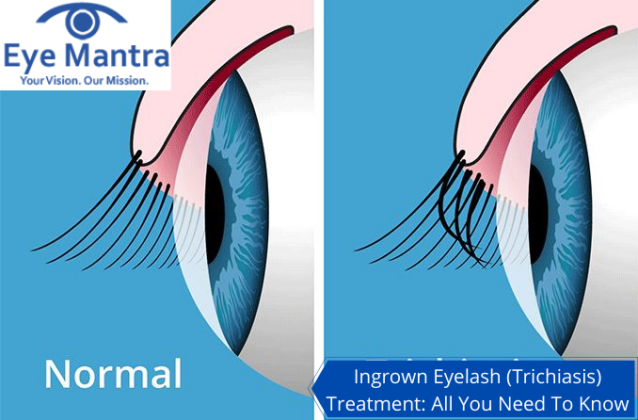
Contents
Ingrown eyelashes are the eyelashes that grow inwards (i.e. into the eye) instead of growing outwards. The medical term for this kind of abnormal and unusual growth is trichiasis.
There are cases when the body hair gets trapped inside the skin and cause pain. They touch skin from the inside and cause redness in the skin. Trichiasis is something different. The eyelashes do not get trapped inside the skin. They grow outside the skin but in the wrong direction.
This may directly lead to immense pain and redness in the eye. In some serious cases, the eyelashes can even cause harm to the cornea inside the eye. Trichiasis is mostly seen in adults. In some rare cases, due to some abnormal reasons, the eyelashes can grow inward in children of younger age as well.
Ingrown eyelash can be a result of a number of causes:
Changes in the direction of the growing eyelashes can majorly irritate the patient’s eyes.
The other prominent symptoms include:
The irritation caused by the ingrown eyelashes is usually enough to prompt a person to make an appointment with an eye doctor. The eye doctor examines your eye with a slit lamp and then tells whether there is an unusual outgrowth of the eyelashes or is just some temporary foreign substance irritating your eyes.
Your eye doctor will also instill a staining solution to show potential damage that may have occurred to your cornea due to the continuous irritation. This test can reveal how serious your condition has grown to be.
The ingrown lashes do not resolve themselves. The only way to resolve ingrown eyelashes is to go to an ophthalmologist for treatment. Some of the treatment options include epilation, electrolysis, cryoablation, etc. In some extreme cases, surgery may be the only option left if the abnormal eyelash growth and eye infections become recurrent.
The treatment of the ingrown eyelashes depends on:
If the unusually ingrown eyelashes are few in number, the doctor simply removes the ingrown hair. It has to be made sure that the underlying cause i.e. the major cause of the unusual outgrowth is removed properly. If the cause has not been removed, the eyelashes can again grow causing the same condition to happen again.
If the eyelashes grow in appreciable number, or when they regrow despite having been removed once; the following treatments can help:
Doctors can use the permanent hair removal method to treat ingrown eyelashes. An ingrown eyelash can be removed using electrolysis. The doctor will damage the follicle with an electric current to prevent the hair from re-growing. Several sessions may be necessary to treat the hair removal process properly.
An alternative to removing hair using electric current can be using laser treatment for removing hair. A 2015 study compared its effectiveness to that of the electric current method discussed above.
Laser hair removal had a success rate of a total of 81% when it was implemented for the first time, just 19 percent of targeted lashes were found to be re-growing. On the other hand, the electric current method had a success rate of 49 percent when it was implemented for the first time, with 63 percent of the lashes re-growing.
Ablation surgery is the kind of treatment in which a doctor directs radio waves or laser waves into the root of the eyelash. This will get rid of the ingrown eyelash and stops from growing them again.
Radiofrequency ablation of lashes and follicles is a simple yet effective method that can be performed under local anesthesia. A small gauge wire is introduced alongside the lash down to the follicle. The radiofrequency signal is delivered for about 1 second with the lowest power setting on cut mode to destroy the hair follicle. Application of 0.02% mitomycin C in conjunction with radiofrequency ablation may help to improve the success rate of radiofrequency ablation treatment.
The procedure involves freezing the ingrown eyelashes and their follicles. After freezing, the doctor removes the ingrown eyelashes.
The probe reaches a temperature of -80 degrees Fahrenheit. In the destruction of lashes of the lower lid, freezing should be performed for 25 seconds. For the upper eyelid, freezing of approximately 35 seconds is performed. After completing both the processes, the cryoprobe is again placed in the area medially. Again, this is performed for 25 seconds and then the area is allowed to completely thaw. The probe is then moved adjacent with a slight overlap and an additional freeze-thaw is performed. You need to be aware that there is significant swelling and pain after cryotherapy to the eyelid. Also, hypopigmentation can occur, and the procedure should probably not be performed in patients with significant pigment. After the cases, all lashes have been removed. This kind of surgery is quite effective but has the potential for complications.
This surgery involves the repositioning of the eyelashes. The eyelashes that have unusually ingrown are repositioned so that they do not cause irritation to the eyes and do not grow again, causing such a condition. This surgery can greatly help people with trachoma.
The best way to treat your eyes is to visit your eye care professional and get your eyes checked regularly. The doctors will be able to assess the best method of treatment for your eye ailment.
Visit our website Eyemantra. To book an appointment call +91-9711115191. Or mail us at eyemantra1@gmail.com. Our other services include Retina Surgery, Specs Removal, Cataract Surgery, and many more.